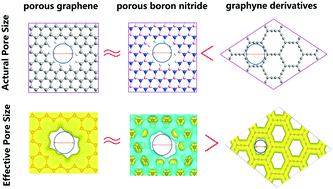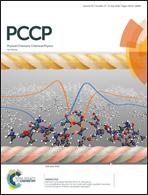Separation selectivity and structural flexibility of graphene-like 2-dimensional membranes†
Abstract
Single-layer membranes of porous graphene, graphyne derivatives (α/α2/β-graphyne), and porous boron nitride (BN) with similar pore sizes (approximately 8 × 6 Å) have been evaluated for separating pentane isomers using first-principles calculations. In spite of their slightly bigger pore sizes, graphyne derivatives only allow linear pentane molecules to go through their native pores, while in contrast porous graphene and BN membranes only block dibranched isomers, i.e., neopentane molecules. Analyses of the geometric changes reveal that the structural flexibility of the membrane determines the penetration barrier. During the penetration of molecules, rigid membranes like graphyne derivatives may exhibit similar distortion to flexible porous graphene and BN; however the energy increase for the former is twice that for the latter. More importantly, the passing molecules experience about two times geometry distortion and four times energy barrier increase when going through rigid membranes compared with flexible membranes. The more deformed passing molecule and the less deformed rigid membrane can result in a much higher penetration barrier. Our results show that the flexibility of porous BN is comparable to that of porous graphene while graphyne derivatives are much more rigid.



 Please wait while we load your content...
Please wait while we load your content...